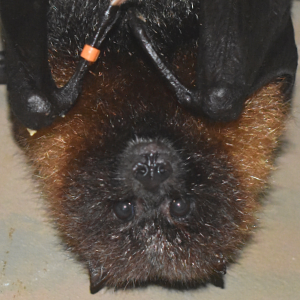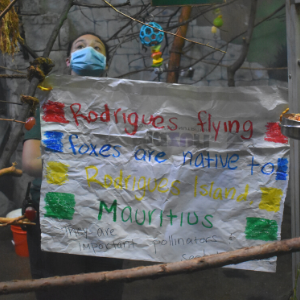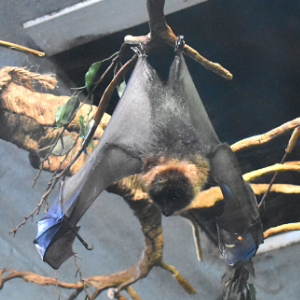We are batty about bats, both in our zoo and around the world. On April 17 each year, we celebrate International Bat Appreciation Day, which recognizes bats as friendly neighbors who help control pest populations, pollinate flowers and even spread the seeds of beautiful, fruit-bearing trees! However, the Akron Zoo has another reason to celebrate this Bat Appreciation Day, since it falls right in between the birthdays of two of the oldest bats in our zoo.
 Wayne and Garth, our two Rodrigues fruit bats, were both born at the Brookfield Zoo in Chicago. Garth was born April 8, 1998 while Wayne was born April 24, 1997. When they arrived on Jan 14, 2000, they were two members of a large population of Rodrigues fruit bats. Rodrigues fruit bats, also known as Rodrigues flying foxes, are known for their erect ears, long muzzles and fuzzy bodies, giving them a fox-like look. These bats can only be found on Rodrigues Island, which is part of the country Mauritius. It's a small island that experiences violent monsoons, so having mature trees to shelter from monsoons is vitally important to this species. In their native habitat, they are active mostly at dusk and dawn to forage for food. They have good eyesight and communicate mostly through visual displays, scents, and touch, though they are relatively solitary by nature.
Wayne and Garth, our two Rodrigues fruit bats, were both born at the Brookfield Zoo in Chicago. Garth was born April 8, 1998 while Wayne was born April 24, 1997. When they arrived on Jan 14, 2000, they were two members of a large population of Rodrigues fruit bats. Rodrigues fruit bats, also known as Rodrigues flying foxes, are known for their erect ears, long muzzles and fuzzy bodies, giving them a fox-like look. These bats can only be found on Rodrigues Island, which is part of the country Mauritius. It's a small island that experiences violent monsoons, so having mature trees to shelter from monsoons is vitally important to this species. In their native habitat, they are active mostly at dusk and dawn to forage for food. They have good eyesight and communicate mostly through visual displays, scents, and touch, though they are relatively solitary by nature.
At the Akron Zoo, our two flying foxes share their habitat with several straw-colored fruit bats. The two were named by keeper Christina Mlinaric in 2008, when she took over primary care of their habitat.
“Since they are the only two remaining members of their species (at our zoo), I named them Wayne and Garth after Garth Algar and Wayne Campbell from Wayne's World,” explains Mlinaric. “I always imagined that they've been ‘buddies’ for a long time, like the movie characters.”
 In reality, the two do spend a lot of time near each other, but this is likely because they are both at the top of the bat hierarchy, so they spend a majority of their time in the highest points of their habitat. Rodrigues fruit bats are not very social, so the two mostly keep to themselves, unlike their straw-colored companions who are far more interactive.
In reality, the two do spend a lot of time near each other, but this is likely because they are both at the top of the bat hierarchy, so they spend a majority of their time in the highest points of their habitat. Rodrigues fruit bats are not very social, so the two mostly keep to themselves, unlike their straw-colored companions who are far more interactive.
“I don't usually see them interact with each other or the other bats, which is characteristic of their species,” says Mlinaric. “The only times I have seen interaction are when they are sharing food bowls with the straw-colored bats, or when a Rodrigues bat is making his way across perching and a straw-colored bat is in his way. Sometimes the straw-colored bat tries to have a standoff with a Rodrigues bat by chattering or trying to prod at him with its nail. In response, the flying fox will expand his wings, presenting his impressive size, which always wins in these cases.”
Despite being solitary old men, these two still have ways of communicating and expressing themselves. Rodrigues bats are relatively musty-smelling and have scent glands that they rub to mark their territory. Sometimes for enrichment, keepers will spray diluted perfumes or rub fruit extracts on pieces of perching in their habitat. This encourages them to find the source of the new smells and rub the backs of their fluffy necks on them, replacing the new smells with their musty smells. They also love “hanging out” in the canopy of their habitat and being hand-fed grapes by their keepers.
“These two are highly food motivated,” says Mlinaric. “They love green peppers, which they would find in their native diet, as well as cooked yams. Sometimes if we offer them a chunk of green pepper or cooked yam, they will hold onto it with their arms and save it for later. Wayne is also very sweet when asking for food from his keepers. Sometimes when we offer him food and our hands aren't close enough, he will bring his claw out to let us know we need to bring the food closer to him.”
 Since Wayne and Garth are older bats, there are some extra provisions made by their keepers in order to keep them happy and healthy. As a part of their regular diet, the bats get a supplement, which aids in joint health. Keepers also make adjustments to the habitat itself to make getting around easier for the two Rodrigues flying foxes.
Since Wayne and Garth are older bats, there are some extra provisions made by their keepers in order to keep them happy and healthy. As a part of their regular diet, the bats get a supplement, which aids in joint health. Keepers also make adjustments to the habitat itself to make getting around easier for the two Rodrigues flying foxes.
“We added pieces of straw mat around some of their perching to make the surface easier for them to grip onto with their nails,” says Mlinaric. “We also made ‘ramps’ between branches with straw mat pieces, for more direct routes from the top of the canopy, where they spend most of their resting time, to the lower canopy, where they eat. I spend a lot of time adjusting the perching or changing out perching in their space and sometimes when I'm working in the canopy, I'll look over and see Wayne watching me. There have been times when he has come closer to me and hung out nearby while I worked on securing perching in his space. ”
We love Wayne and Garth and are so grateful they are members of the Akron Zoo family. Be sure to “swoop in” sometime this month to wish a happy birthday to these “old bats,” and to visit more than 1000 animals from around the world. We hope to see you soon!
